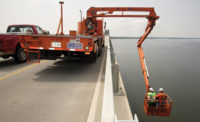Bridge inspections reached a huge milestone in April, when the Federal Highway Administration (FHWA) began collecting “element-level” bridge condition data from state departments of transportation.
In an element-level bridge inspection — mandated by the latest highway bill, Moving Ahead for Progress in the 21st Century (MAP-21) — “each square foot of the bridge deck, and its other elements, such as the joint seals, receive a separate rating,” according to a statement from the FHWA. “Dividing bridge components into smaller, more manageable elements will ensure engineers understand the extent of bridge deterioration, which will help them make more informed decisions about repair, preservation and replacement.”
Under the old system, bridge inspectors assigned scores from zero through nine to large components of a bridge, such as the superstructure, deck, and substructure. The score reflected the condition of the component.
MAP-21 required states to begin last October collecting element-level data on their bridges and to begin reporting that element-level data to the FHWA in April.
Element-level inspections quantify the condition state (good, fair, poor, or severe) of each element of the bridge, such as girders, floor beams, and bearings, and identify how much of the element — in length or area — is in that condition state.
 |
| LESHKO |
Over the past decade, even as the total number of bridges in the nation's inventory increased by nearly 15,000 — from 595,668 to 610,749 — the percentage of bridges classified as structurally deficient dropped from 13.1% in 2005 to 10% last year.
 |
| BERRY |
 |
| HERRMANN |
“We’ve had a history within our state to collect element-level data, based on an older system, which is called CORE, or the commonly recognized elements,” says Jim Long, bridge inspection chief for the Pennsylvania Dept. of Transportation, “so we don’t necessarily see that it’s going to create a burden, so to speak. There’s already been a practice of doing it at some level.”
Ohio is another state with experience rating bridge elements.
“ODOT inspects all bridges annually, a higher standard than current FHWA mandates,” says Matt Bruning, press secretary for the Ohio Dept. of Transportation (ODOT). “We already collect the data being requested under this proposal, so it’s really no extra work for us at all.”
Element-level data can also flow directly into models of bridge deterioration to predict how fast bridges will crumble and how fast the cost to repair them will escalate.
“I think it’s a good idea,” says Herrmann. “The more information you can get, the more you can justify why things have to be done in terms of rehabilitation or repair.”
“Those all get rolled up now into what can be utilized for an asset management program,” says Brian Leshko, bridge inspection program lead at engineering firm HDR, “so that FHWA and the states can better prioritize the limited resources they have to preserve the condition of these structures.”“It’s going to enable not only the inspector but the owner of a bridge to have much better, more detailed information, the ability to use that information to facilitate the necessary repairs, come up with a budget in order to do these repairs,” says Darrell Berry, senior manager at Mead & Hunt, “and will ultimately lead, in my opinion, to safer bridges.”“They’re going to have to put that all together and then fill in the blanks for the four different condition-state definitions,” says Andy Herrmann, a past president of the American Society of Civil Engineers. “Some states are further along in looking at elements. New York state is one of those states that’s been looking at elements for a while. Other states may be just doing the basics that the feds require.”


Post a comment to this article
Report Abusive Comment